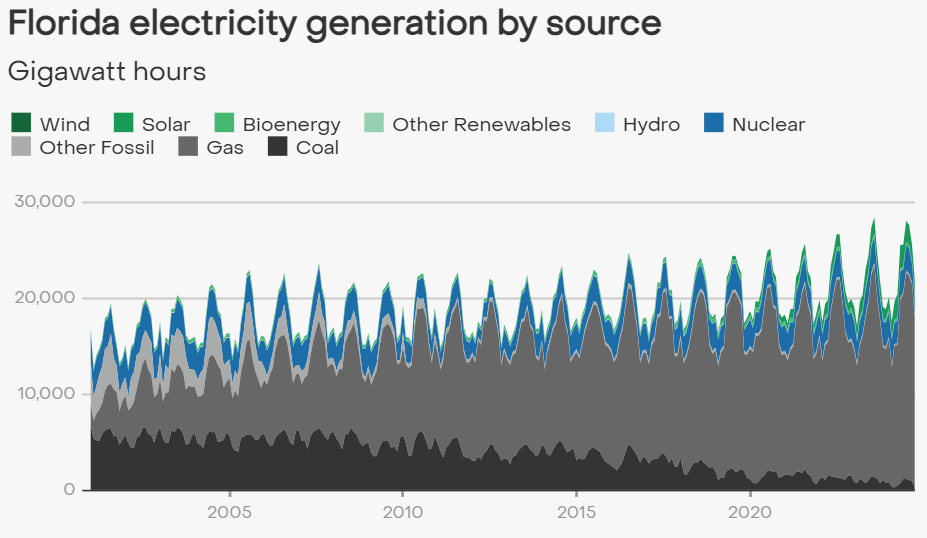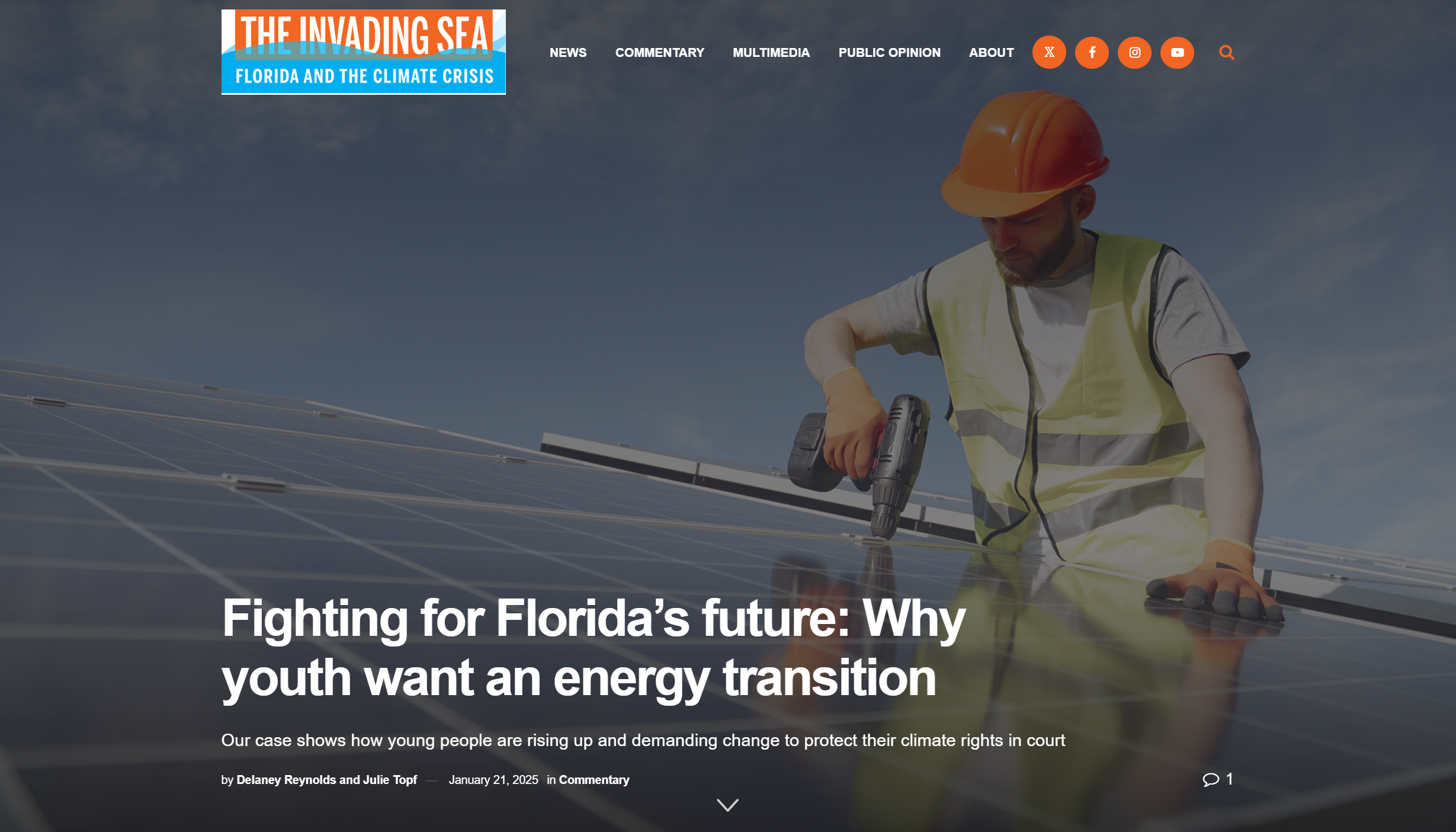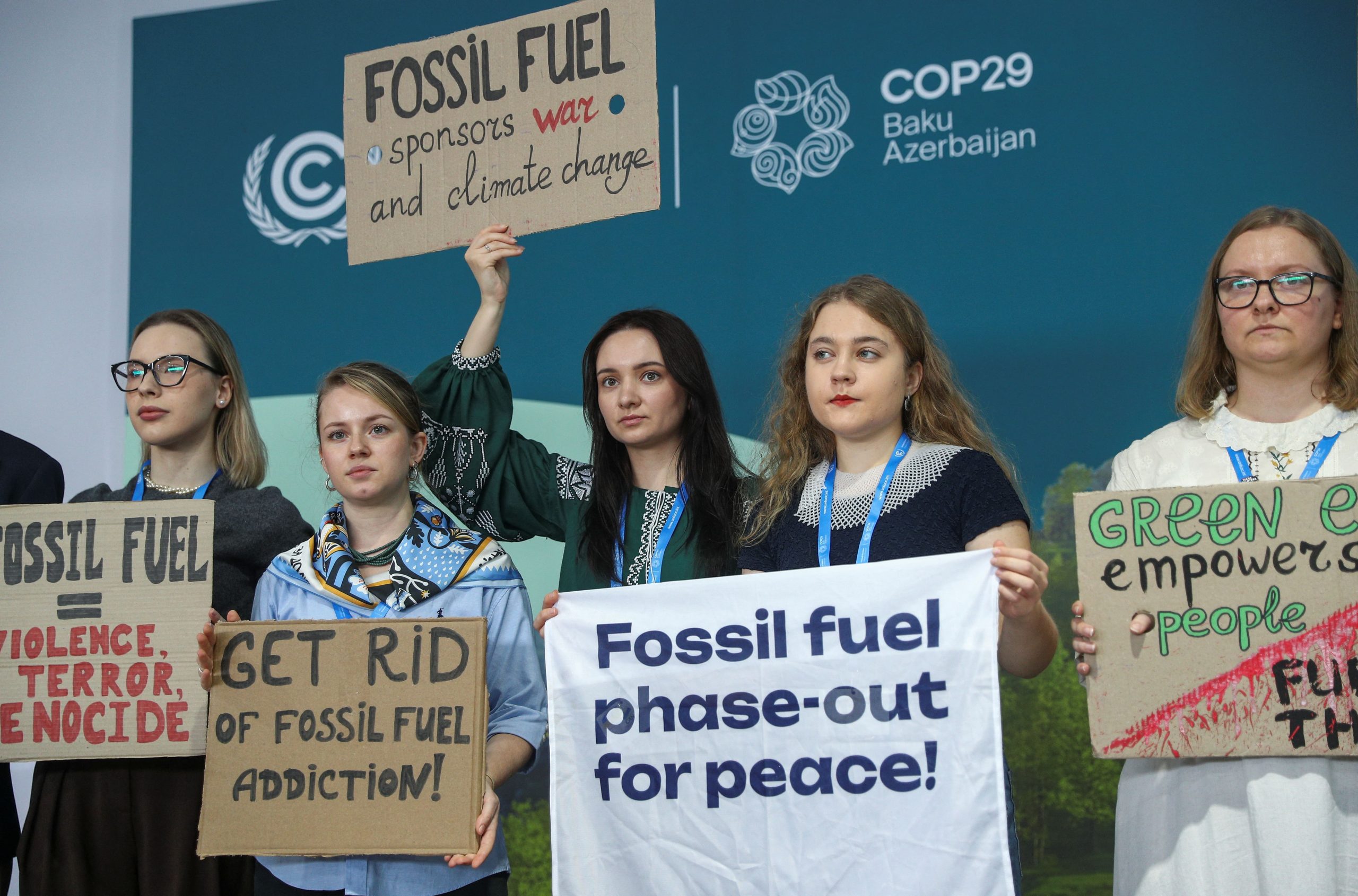Solar Superpowers in the Age of Electricity
I’m pleased to share a recent editorial that I wrote with my friend (and fellow Plaintiff) Julie Topf about the lawsuit I filed in October against the Florida Public Service Commission (PSC) that’s been published as part of the Miami Herald’s The Invading Sea series. The editorial explains that for at least as long as Julie and I have been alive, we are both 25, the PSC has approved every single 10-Year Site Plan that Florida’s electrical utilities have submitted for review as being “suitable,” despite the fact that none of those plans appear to comply with long established state laws that demand a shift away from fossil fuels and towards renewable energy so as to lower consumer costs, diversify Florida’s fuel sources, and best protect our natural environment. Laws like the Florida Renewable Energy Policy and Florida’s Comprehensive Plan, for example, that the PSC is charged with regulating and is supposed to enforce but are systemically being overlooked while allowing our electric utilities to build an energy system based almost entirely on sourcing their power from polluting fossil fuels.
Today about 84.9% of Florida’s electrical energy is generated from fossil fuels and, of that, a shocking 81.3% is from natural gas, a pollution generating fossil fuel that emits methane, a deadly chemical, into our atmosphere and oceans. Consider the following illustration from the energy consulting firm Ember, based on data from the U.S. Energy Information Administration through September of last year. As you can see, while coal (illustrated in black) has steadily been declining as a source of energy generation in Florida over the last 25 years the “gas” category, one dominated in our state by natural gas, has skyrocketed.
Unless and until the Public Service Commission stops rubber stamping the electric utilities’ 10-Year Site Plans and starts enforcing our established laws, Florida will continue to be one of the largest polluters in the world while offering our citizens some of the most expensive power on the planet as it misses an incredible opportunity to help lead America into the renewable energy future, the Age of Electricity, that much of the rest of the world is already embracing. You see, 2024 is being viewed by experts as the year that solar power and battery storage for that power truly began reshaping the world’s energy systems at impactful scale as “Solar Superpowers” are emerging all over the globe.
Consider that the International Energy Agency’s 2024 World Outlook makes it clear that while the new U.S. political regime embraces fossil fuels such as oil and gas like it’s still the 1940’s, the rest of the world is enthusiastically embracing renewable energy. In fact, the report suggests that clean energy is on track to generate more than half of the world’s electricity before 2030 and that demand for all three fossil fuels (coal, oil, and gas) is projected to peak by the end of this decade as clean, renewable energy is entering the world’s energy system at an unprecedented rate. Here’s how Dr. Faith Birol, the IEA’s Executive Director, explains the worldwide transition to the Age of Electricity in which energy is sourced from clean renewables such as solar power:
In previous World Energy Outlooks, the IEA made it clear that the future of the global energy system is electric – and now it is visible to everyone. In energy history, we’ve witnessed the Age of Coal and the Age of Oil – and we’re now moving at speed into the Age of Electricity, which will define the global energy system going forward and increasingly be based on clean sources of electricity.
And with such things in mind, young people all over America, certainly including my friends and fellow Plaintiffs here in Miami-Dade, are forced to ask just why is it that our political leaders and regulatory agencies like the Florida Public Service Commission are so intent on protecting the polluters rather than positioning our country as the world’s leader in renewable energy?
By Delaney Reynolds and Julie Topf
If you grew up in South Florida over the last two decades, as we have, the impacts of climate change increasingly consume your life. Whether rising sea levels along our shores or dead coral reefs in our waters, we see it with our own eyes. We feel it becoming warmer whenever we step outside as record-breaking temperatures become more common and heat surrounds us, not just in the summer, but always.
Our lives have been filled with extreme flooding that disable our neighborhoods even on sunny days, rain bombs that bring life to a standstill, gentrification from developers rushing to capture our limited supply of higher ground and increasingly more destructive monster hurricanes. If you love Miami-Dade like we do, the harm to our lives and threat to our future from the climate crisis is as undeniable as it is devastating.
As our generation inherits this problem, we are focused on addressing the cause –– pollution from fossil fuels –– before it’s too late. This requires a serious shift to renewable energy, a transition that faces obstacles from both Florida’s electric utilities and their exclusive regulator.
Florida’s electricity sector alone produces more climate pollution than many countries’ entire economies, including Colombia, a country with nearly 30 million more people than Florida. In 2022, Florida’s electric utilities themselves produced 40.1% of all climate pollution in our state and have spent decades building a supply chain almost entirely reliant on methane gas, a toxic fossil fuel pollutant that causes 80 times more warming than carbon.
Today, 84.9% of Florida’s electricity generation is from fossil fuels, with a shocking 81.3% supplied by gas. Florida’s three largest electric providers –– Florida Power & Light (FPL), Duke Energy and Tampa Electric (TECO) –– distribute 81% of our state’s electricity, yet source a tiny fraction of their energy from clean renewables like solar. Just 7.3% of FPL’s electricity, 6.3% of Duke’s and 8.0% of TECO’s are sourced from renewables –– pathetic results after a century in “the Sunshine State.”
In 1951, our legislature bestowed the Florida Public Service Commission exclusive authority to regulate electric utilities in the public interest. The commission’s duties include ensuring utilities comply with the Florida Renewable Energy Policy and Florida’s Comprehensive Plan, both designed to promote renewable energy. However, since at least 1999 –– for the 25 years we have both been alive –– the commission has repeatedly approved every single one of our utility’s long-term energy plans, called “10-Year Site Plans,” despite their reliance on fossil fuels and failure to comply with our laws.
The commission’s blatantly utility friendly “rubber stamp” approach is systematically failing us and our environment. It’s locking our state into fossil fuel dependency for decades to come, further exacerbating the climate crisis, with youth, like us, facing disproportionate impacts and risks. That’s why we, alongside four other Miami youth, have filed a lawsuit, Reynolds v. Public Service Commission, asserting that the Commission’s decades-long approval of fossil fuel-dependent energy plans violates our constitutional rights to life, and to enjoy and defend life, as guaranteed under Florida’s Constitution.
If the court agrees, it could declare the commission’s rubber-stamping unconstitutional and force Florida toward a safer energy future. Just like other youth-led constitutional climate cases, including groundbreaking victories in Held v. State of Montana and Navahine vs. Hawai’i Department of Transportation, this case shows how young people are rising up and demanding change to protect their climate rights in court.
The science and solutions are clear: For over four decades, scientists have proven that 100% renewable energy systems can be achieved by or before 2050, including in Florida. The transition to clean energy is no longer a matter of technical feasibility or economic viability. It is also not a political issue, and cannot be treated as such, because climate change transcends political ideologies –– it impacts us regardless of party lines and regardless of whether we “believe” it is real.
This case is about more than just energy policy; it’s about safeguarding our future. We have the right to grow up in a world where our health, safety and environment are protected, not harmed by the decisions our government makes today. It’s time for Florida to take bold action and lead by example to protect the climate and ensure a livable future for us all.
 (From left) Delaney Reynolds and Julie Topf
(From left) Delaney Reynolds and Julie Topf
Delaney Reynolds and Julie Topf are two of the plaintiffs involved in Reynolds v. Public Service Commission, a youth-led constitutional climate lawsuit in Florida.








